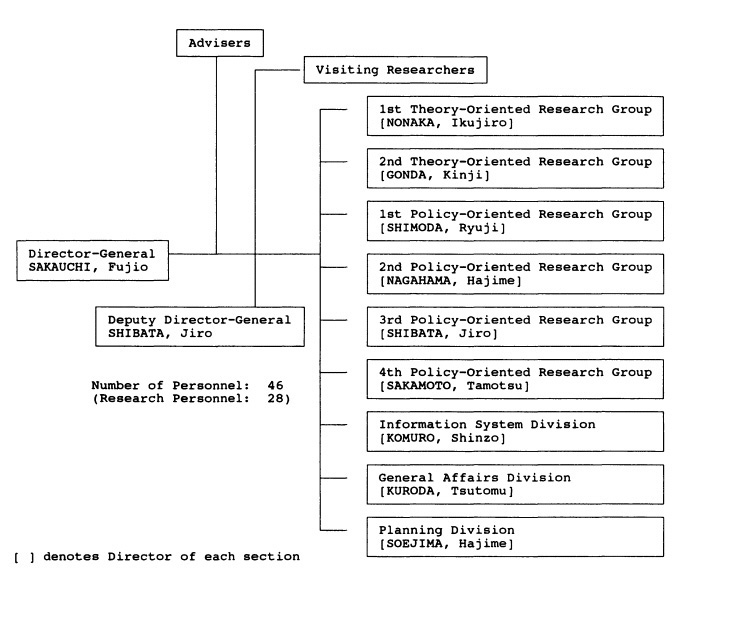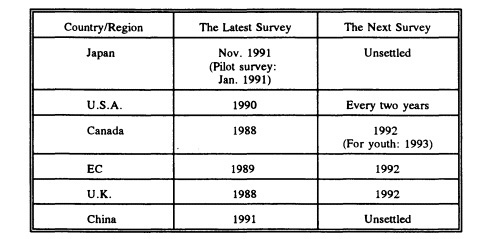Summary of Introductory Comments
Richard Pearson
Important efforts are under way in a number of countries to organize information about scientific and technical careers using common terminology and common data gathering techniques. The paper by Gunnar Westholm describes the specific efforts in this area by the Organization for Economic Cooperation and Development (OECD), while that by Hajime Nagahama offers a closer look at the organization of studies that have been undertaken in Japan to monitor the development of that workforce.
Together, both papers illustrate the challenges that lie ahead in any international effort to gauge the stocks and flows of scientists and engineers.
There are many important questions that must be answered before we can hope to achieve a common understanding of international trends in science and technology (S&T) careers. Some key questions include:
-
Why are we interested in careers? Particular issues include concerns over shortages that delay development and innovation, surpluses of applicants leading to unemployment, and information to "plan" educational provision.
-
What do we mean by "career"? Do we mean the period of 30-40 years of employment, or is the priority the critical stage of transition (perhaps 5-10 years) from education into the career path? Is a career something that has continuity and coherence or is it simply a summation of education and a series of different jobs?
-
How far should we be interested in the 18-year-old and, indeed, younger students? These can be critical times when career counseling can have significant payoff in the course of promoting S&T careers.
-
What do we need to know about careers? Can we "predict" careers for the future? How will this information help? Why not leave the development of the S&T workforce to market forces?
-
What do we know about the different routes that lead people in different countries to undertake S&T careers?
-
How do equity issues figure into the development of careers?
-
How do we handle the issue of unemployment and underemployment in S&T? What advice should be given regarding careers in apparently overpopulated disciplines?
-
How do such factors as international mobility and the "brain drain" phenomenon influence the career process? When we monitor S&T careers, are we interested in local market and/or global market factors?
-
Do we mean the same things when we refer to S&T from country to country?
-
What can we do about the paucity of data on S&T employment and careers? We need the data if we want to pursue the "planning" route. Additionally, if we want the market to work, we need the data to inform decisionmakers.
These are some of the issues that we have to consider if we are to determine our success in bringing the concept of career to bear on information gathering and analysis.
Recent Developments in International Science and Technology Personnel Data Collection
Gunnar Westholm
It is generally recognized that the combination of science and technology (S&T) and human resources—notably scientists and engineers and also technicians—plays a key role in economic development and improved social and environmental welfare and that this role will be increasingly reinforced in the future.
A better understanding is needed therefore of the nature and structure of both the S&T systems and the current and future situation (in the short-, medium-, and long-term) for these categories of skilled personnel, measured in terms of supply and demand.
A multitude of national and international stock and flow data and related literature already exists, which may be used for the analysis of S&T personnel (however defined). All countries have their national series of population, labor (including industrial employment), and educational statistics. While these data are frequently available for quite a long time period, they have rarely been collected for the purposes of S&T analysis.
UNESCO'S DATA ON THE WORLD STOCK OF S&T PERSONNEL
Perhaps the best known international statistics are those published by the United Nations Educational, Scientific, and Cultural Organization (UNESCO). These statistics, however, still present serious problems of international comparability, and the data are very aggregated and not always up-to-date.
According to UNESCO's statistics published in late 1992, the total stock of scientists, engineers, and technicians in the world in 1985 was estimated to be about 110.8 million compared to 79.2 million in 1980—an increase of broadly 40 percent. Extrapolating these figures, one may perhaps estimate that toward 1990 the world stock of S&T personnel could be at least 150 million. This is an interesting macro indicator in its own right but not very useful for S&T analysis in the absence of a more detailed breakdown of the categories involved, or placed in relation to a number of other economic and demographic variables.
The distribution by principal geographical zones of this UNESCO stock of S&T personnel is far from balanced. Around three-quarters of these scientists, engineers, and technicians are found in the developed countries, which account for about one-quarter of the world's total population. The remaining quarter of the S&T stock is found in developing/industrializing countries, which have three-quarters of the world population.
The concentration is particularly strong in North America. The United States and Canada together, with 6 percent of the world population, have some 30 percent of the world's S&T labor force. Europe (including the former Soviet Union) is also well represented, with around one-third of the S&T stock but only 16 percent of the world population.
For the Asian region, the UNESCO statistics aggregate highly industrialized countries, such as Japan and the "Dragon countries" (Hong Kong, South Korea, Singapore, and Taiwan), with industrializing countries, such as the People's Republic of China, India, and
Indonesia. The absolute S&T personnel potential in Asia is of the same magnitude as that of North America (30 percent) compared to its share in the world population of 60 percent.
Latin America and Africa are the regions least well off, with only 4 and 1.5 percent, respectively, of the world potential of S&T personnel; Latin America has 8 percent and Africa some 10-11 percent of the world population.
OECD EXPERIENCE OF MEASURING R&D PERSONNEL
The Organization for Economic Cooperation and Development (OECD) has a long experience—going back to the early 1960s—of collecting data on human and financial resources devoted to research and experimental development (R&D) activities, but, though essential, R&D is only one of a variety of S&T activities.
The OECD guidelines for the measurement of R&D, the so-called Frascati manual, are also used by UNESCO and the Statistical Office of the European Commission (Eurostat). These two international agencies are also directly involved in the ongoing work of developing a human resources manual on S&T (see below).
All OECD statistics are collected within an internationally accepted statistical framework and, if necessary, adjusted before publication to assure international comparability. For such comparisons it is necessary to work at the level of the lowest common denominator, which, in practice, may be at a rather aggregated level. For specific analytical purposes, where very detailed micro data are needed, most OECD (and UNESCO) data may well be too macro.
EFFORTS TO COLLECT S&T PERSONNEL DATA AT THE OECD
For a variety of reasons—one being shared responsibility between directorates—the OECD has never seriously embarked on any regular collection of direct S&T personnel data, only of proxy data such as education and selected labor statistics.
S&T personnel data have been gathered on an ad hoc basis over the years, on the occasion of specific policy studies, such as those of the "brain-drain" in the late 1960s and early 1970s, the involvement of women in S&T, forecasts of the demand for and the supply of R&D personnel, or questions related to the aging or the mobility of the R&D workforce.
Interest in S&T personnel measurement has, however, remained unchanged, with jealous reference to work in the United States and the impressive and well-known data series issued in the National Science Foundation's Science and Engineering Indicators volumes.
A first attempt to remedy the lack of S&T personnel data was undertaken at the OECD in the early 1980s. A workshop was arranged in 1981, pushed and pulled by American initiatives, with a view to defining the conceptual framework for the international collection of such statistics. Some 30 experts from 13 countries participated. Following the discussions, the Secretariat launched a couple of experimental questionnaires requesting information on national stocks of S&T personnel, "piggy-backed" to its regular R&D surveys. The results were rather discouraging: only some four or five countries responded, and the scarce data could not be used for any serious analysis.
Perhaps the time was not ripe for this kind of data reporting. The conceptual guidelines were not satisfactory and the timing was inadequate. At that time, the principal sources of data were the national censuses, which took place at rather long time intervals. The main reason for the exceptionally low response rate was probably that the national R&D statistics experts were not themselves involved in the underlying educational and/or employment statistics, and their colleagues, in turn, were not fully motivated to participate in the exercise.
THE OECD TECHNOLOGY-ECONOMY PROGRAM
Today, work on S&T personnel statistics is being driven by the need for information for policymakers.
The interest in the broader concept of S&T personnel was intensified on the occasion of a "Technology-Economy Program" (TEP) at the OECD (1988-1991). This was a project on policy crossing the traditional directorate borders that highlighted, among other things, the key role of human capital—once again stressing that of scientists and engineers—in the innovative process. Drawing essentially on empirical evidence, backed by scattered national statistics, the
report paid specific attention to the risks of severe quantitative and qualitative skill shortages toward the end of the century, while admitting the difficulties in forecasting both the demand and the supply. (See TEP—The Technology/Economy Programme —Technology and the Economy—The Key Relationships OECD, Paris, 1992.)
RECENT AND EXPECTED DEVELOPMENTS IN THE S&T WORKFORCE
Significant increases in the demand for S&T personnel in industry, services, and higher education are anticipated in many countries. Specific worries are expressed concerning difficulties in the higher education sector, which saw a rapid increase in the number of students and faculty in the 1960s and early 1970s as a result of the postwar baby boom and as a consequence of national social equity ambitions. These trends were favored by general economic expansion.
Massive faculty retirements may occur causing intensified recruitment needs in the sector already by the mid-1990s. If there is (as may be expected) strong parallel demand from trade and industry, with capacities for offering better salaries for the same personnel, severe recruitment problems could occur. On the other hand, new career openings will, after years of advancement blockage, be offered to younger faculty.
The TEP report discusses the demographic fall in national 18- to 24-year-old cohorts, which traditionally constitute the essential source of ''new blood" into universities. From around 1980 to the mid-1990s, the number in this age group will fall between one-quarter and one-third in most of the OECD countries.
There is apparently no direct linear relationship between the number of age groups concerned and the number of new entrants into the higher education system. Studies undertaken by the Institute of Manpower Studies (IMS) in the United Kingdom have shown that the higher social classes, which broadly represent one-third of the population, traditionally account for some two-thirds of all higher education entrants. Since the birth rate propensities of these social classes appear to have decreased at a lower pace than that of the overall population, the expected reductions in the number of young people entering higher education have been considerably moderated.
THE INCREASING ROLE OF WOMEN IN S&T
The expected fall in student numbers has also been compensated by continued increases in overall enrollment rates, largely explained by the growing participation of women (in some countries also ethnic minorities, students from abroad, and mature students).
Female students currently, or will very soon, account for at least one-half of all new entrants into the higher education system with, of course, large variations between disciplines (and countries). They are typically over represented in the social sciences and humanities. And while they now represent at least 50 percent of new medical students, they are underrepresented in other S&T disciplines, like engineering and physics. In most areas of S&T, female participation rates appear to fluctuate around 15-20 percent only of the total (but sometimes even more—the same is frequently true also for ethnic minority and mature student groups), and these proportions seem to remain rather stable over time. Increased participation of women in higher education will therefore probably be only marginal whereas, provided appropriate measures are taken, there are many reasons to believe that their interest in S&T could be intensified.
DECREASING GENERAL INTEREST IN S&T STUDIES AND CAREERS
The general positive trend in numbers of students is offset by apparently declining interest in S&T subjects and careers. S&T degree recipients are increasingly attracted by nonscientific or technical professions (such as banking, business, and real estate), which offer better salaries and working conditions and perhaps higher professional and social status than traditional S&T careers.
The supply of S&T personnel is also increasing in many countries as a result of former technical training colleges being upgraded to engineering school status. Efforts are also being undertaken to convert or retrain graduates with nonscientific degrees into S&T studies and professions, though this transferability is probably much more difficult than the other way around.
The need for intensified continued or vocational training was highlighted in the TEP report. (This is one of the activities discussed in the ongoing preparation for another OECD manual on the measurement of "intangible investment.")
FORECASTING THE SUPPLY AND DEMAND FOR S&T PERSONNEL
The TEP experts underline that future demand for scientists and engineers is still more difficult to predict than supply. In addition to direct and indirect demographic factors, such as mortality and retirement age, demand is affected by a number of uncertain variables such as economic growth, changes in the relative weight of different sectors of the economy (less manufacturing versus more private and/or public services), changes in the technology intensity (however defined) in these sectors, and changes in governmental policies (including "big" science programs), etc. At the same time, in some S&T areas there is oversupply or underemployment of qualified personnel, while in others, employers still have problems recruiting appropriate staff. Increasing international, as well as domestic, mobility of scientists and engineers between regions, professions, universities, and industries and organizations also makes forecasting supply and demand hazardous.
THE IMPACT OF PUBLIC S&T/R&D PROGRAMS
There is also increasing interest in how the current S&T labor force is actually used. In the major OECD countries, an essential part of the state budget and much of the public R&D spending goes to defense-related programs, where many of the most highly qualified S&T personnel are engaged. Some examples include: defense R&D in 1990 represented 63 percent of public R&D funding in the United States, 43 percent in the United Kingdom, and 40 percent in France (to be compared with, for instance, 6 percent in Japan and 14 percent in Germany). These percentages, which were already lower than a few years earlier, have continued to decrease in the United States, France, and Germany (59, 35, and 11 percent respectively in 1992), remained stable in Japan, but increased slightly in the United Kingdom (45 percent in 1992). (SOURCE: OECD Main Science and Technology Indicators—Biannual).
Considerable reductions in defense spending are currently envisaged in all OECD countries. This will necessarily have a bearing on their needs for S&T/R&D personnel and may result in serious cuts in this labor force and, if not properly channeled, in loss of vital skills, at least until more civil-oriented employment alternatives can be found. Such conversions are hard to handle; this is one of the most crucial problems—resulting in both a domestic and international "brain-drain"—with which many of the new eastern countries are currently wrestling.
THE OECD S&T MANUALS
The TEP report regretted the lack of accurate statistical tools for a better policy understanding of the human capital situation, and in 1991 the Scientific, Technological, and Industrial Indicators Division (STIID) of the OECD Directorate for Science, Technology, and Industry was invited to undertake the preparation of a manual measuring stocks and flows of human S&T resources. (In the autumn of 1992 the STIID was renamed the Economic Analysis and Statistics Division.)
The OECD is already a world leader in methodological developments for the collection of R&D and S&T statistics and indicators and has recently issued guidelines, in the Frascati family of manuals, on the measurement of innovation activities and the technology balance of payments. Work is under way for a patents manual and is well advanced on manuals on the measurement of "intangible investment" and high-, medium-, and low-tech activities. Corresponding databases have been established or are under development.
The OECD Directorate for Education, Employment, Labor, and Social Affairs collects educational statistics in a common OECD/UNESCO/Eurostat questionnaire, although each international agency has its own databases and database management. These third-level data on students and faculty will serve as essential inputs for the forthcoming S&T personnel databases.
The S&T manuals should provide the statistical framework for complete databases using standard international classifications wherever possible and ensure structured links to already existing databases. The guidelines should indicate how available data could, or could not, be used. The manuals are intended to meet the very diverse needs of both producers and users of data. The guidelines should be addressed for both national and international statistical purposes (including analysis). Even if, until quite recently, all these manuals were essentially directed toward the needs of economically developed countries (typically members of the OECD), there is now increasing demand from non-
member countries, including the industrializing world.
Preparing such manuals is a time-consuming exercise. More time is needed for completely new statistics (such as the R&D or innovation statistics) than for the use of S&T purposes of already existing data, even if they were originally assembled for reasons other than S&T policy (i.e., the technology balance of payment and the patents statistics). The S&T personnel manual project belongs to the latter category.
The procedure is usually as follows: after theoretical discussion—sometimes starting at a very academic level—and the preparation of a draft manual, a pilot survey is undertaken. Drawing on the results of this first survey, the manual may be revised, and, if necessary, the experience renewed before regular surveys are launched and related databases built up.
THE NEW S&T HUMAN RESOURCES MANUAL
In the case of the human S&T resources manual, the OECD had asked Dr. Richard Pearson of the IMS, who served as a consultant, to prepare the first draft. The OECD and the IMS teams began by examining available theoretical literature. They decided to draw as much as possible on already existing practical national and international experience. This was done through an ambitious inventory survey, using a rather comprehensive set of questionnaires prepared jointly by OECD and Eurostat, addressed to member countries and to UNESCO.
All this work has been fully backed by the European Commission in Brussels, in particular the DGXII, the Directorate General for Science, Research, and Development.
No less than 22 of the 24 OECD member countries responded—of course in more or less detail—to the inventory survey. This exceptionally high response rate testifies to the general interest in these S&T personnel issues, even if the results may have been biased by the composition of the group of respondents where R&D/S&T indicators experts predominated.
The preliminary conclusions of the inventory were presented by Eurostat at a first international workshop in Paris in October 1992, gathering some 70 experts from 25 OECD and non—OECD member countries, the European Commission, and UNESCO to discuss Dr. Pearson's draft manual.
The final results of the inventory were analyzed by Eurostat and served as background information at the expert meetings in Luxembourg and Paris in 1993 for revision of the manual.
Some of the principle conclusions of this exercise are presented—pell mell—below.
There is very little systematic data collection of S&T personnel, and more use is made of various kinds of proxy statistics. Only three or four countries (including the United States) have adopted some kind of a national definition of S&T personnel and collect corresponding data. R&D and educational policies appear to be the most important markets for this kind of indicator. National considerations prevail over international comparisons. Only some of the largest countries undertake systematic efforts of modeling (defined as the use of formal mathematical models for long term projections) or forecasting (understood as short or medium-term outlooks based on known factors such as demographic developments and educational enrollments) of S&T personnel. Central statistical personnel data (notably education and labor statistics) are the prime source, but similar information is also drawn from associated agencies. It should be possible to extract and use sources as far as both levels of education and (broad or detailed) fields of science are concerned (including the social sciences and the humanities). Data on gender and age appear to be generally available. Information on national and international mobility (including data on nationality, etc.) appears to be rather scarce, even if several countries undertake "first destination" surveys of graduates.
TERMINOLOGY AND DEFINITIONS
The preparatory work revealed that there is considerable confusion in the terminology employed and that these semantic descriptions also reflect broad variations in the coverage, or perception, of the data. For instance, the following denominations of S&T personnel (or manpower) were frequently used:
-
highly qualified manpower
-
scientific and technical or technological personnel
-
scientific and engineering personnel
-
scientific, technological, and engineering personnel
-
scientists and technologists
-
highly skilled personnel
-
highly qualified technological manpower
-
academic-level researchers and teachers
-
research and technological development personnel
At the previously mentioned workshop it was decided to use the denomination "human resources for S&T" (HRST) for the purpose of the new manual and future work.
Only one of the above classes—scientific, technological, and engineering personnel-seems to have an internationally adopted definition, but the Frascati manual also gives definitions of various categories of R&D personnel.
In its report Recommendation Concerning the International Standardization of Statistics on Science and Technology, adopted by the General Conference in Paris in 1978, and in the subsequent Manual for Statistics on Scientific and Technological Activities, UNESCO defines scientific, technological, and engineering personnel as follows:
Scientific and technical personnel can be defined as the total number of people participating directly in S&T activities in an institution or unit and, as a rule, paid for their service. This group should include scientists and engineers, technicians, and auxiliary personnel …
Later in the manual, UNESCO also defines what is meant by the "scientific and technical manpower potential" for which two categories are identified: the "total stock of qualified manpower" and the "number of economically active qualified manpower."
The two categories are defined as follows:
(The) Total stock of qualified manpower comprises the total number of persons with the necessary qualifications for personnel in categories "scientists and engineers" and "technicians," regardless of economic activity (production, S&T activities, the professions, no gainful employment, etc.), age, sex, nationality, or other characteristics present in the domestic territory of a country at a given reference date.
(The) Number of economically active qualified manpower comprises the total number of persons with the necessary qualifications for personnel in categories "scientists and engineers" and "technicians'' who are engaged in, or actively seeking work in, some branch of the economy at a given reference date.
The following graphic illustrates the relationship between these two UNESCO main aggregates and the scientists, engineers, and technicians engaged in S&T activities (of which R&D):

Above, several aggregates of S&T personnel that could be measured and used for data collection and analytical purposes have been indicated. One of these aggregates may be that of "scientists and engineers," which is perhaps too frequently used as a block, with no separate distinction between the two elements.
DEFINITIONS IN TERMS OF QUALIFICATIONS OR OCCUPATION?
Here again, several approaches are possible. Should the categories of S&T personnel be identified in terms of their formal educational background (i.e., by qualifications), or in terms of the jobs they are actually performing (i.e., by occupation)? Or perhaps by a mixed qualification/occupation criterion (for instance, when classifying people who do not possess the usual requested diplomas for the jobs they are performing but who, all the same, have the corresponding professional skills and experience)?
Given that both approaches meet specific policy needs, participants wished that both the qualifications and the occupation criteria be maintained for further
conceptual work, with a slight preference for the first approach (due to better data availability).
SHOULD TECHNICIANS BE INCLUDED?
It is, furthermore, not very clear, when we talk about scientific, technological, and engineering personnel, whether the category of technicians (or people with corresponding educational level backgrounds or professional experience) should be included. Lack of competent technical staff may create problems just as serious as an insufficient supply of scientists and engineers, and concern has been expressed by OECD, and industrializing countries as well, of risks of forthcoming "bottlenecks" in the supply of technicians.
At the workshop, participants spoke in favor, but far from unanimously, of the inclusion of technicians in the coverage of the HRST. The principal argument in favor of their exclusion was essentially one of practical measurement problems; whereas it is quite easy to define what we mean by scientists and engineers in terms of the International Standard Classification of Occupations and the International Standard Classification of Education, it is more problematic to define the technicians (and associated categories).
WHAT DISCIPLINES SHOULD BE INCLUDED IN S&T?
Another question concerns the coverage of the science and technology activities themselves. The R&D statistics manual, which to some extent serves as a model for the HRST manual, recommends the inclusion of the natural sciences and engineering, including the agricultural and medical sciences, on the one hand, and the social sciences and humanities on the other.
In his draft manual, Dr. Pearson proposed that only the natural sciences and engineering should be covered—the social sciences and humanities should be excluded. This appeared to be a typically Anglo-Saxon position that met with resistance from countries with the "Wissenschaft" approach. Some workshop participants spoke in favor of including the social sciences but not the humanities. It was finally agreed to recommend a coverage identical with that of the R&D statistics, though with sufficiently distinct subclasses to permit the separate identification of the social sciences and humanities (to make their exclusion possible).
ALL SKILLED PERSONNEL OR ONLY THOSE ENGAGED IN S&T?
Similar discussions took place on whether we were interested in the total potential ("reserve") of S&T personnel (to be identified as all people with appropriate educational backgrounds or working in such occupations) or only those who are economically active, and, if so, whether we should concentrate on only those who are directly involved in S&T activities (such as the second UNESCO category mentioned earlier). The latter approach would probably exclude all medical and associated practitioners and, of course, all people with S&T training but working in nonscientific activities. Here, people working in the higher education sector (i.e., the third level of the national educational system) would be included in the data, but should people with the same S&T diplomas working at lower levels of the educational system really be excluded?
DEPRECIATION OF QUALIFICATIONS
Another directly related problem was raised. S&T are activities in rapid evolution, necessitating continuous theoretical and practical updating. Should people with a basic S&T training obtained in areas of rapid change, say 20 years ago, still be included in the S&T potential? Should retired scientists and engineers or persons older than, for example, 70 years, still be considered for the measurement of total S&T potential?
No specific recommendations were made by workshop participants on this point, but, at a later stage of the discussions, it was recommended that highest priority be given to the measurement of HRST under the age of 70.
STOCKS AND FLOWS OF S&T PERSONNEL
The 1981 and 1992 workshops concluded that information is needed on both stocks and flows for a better understanding of the S&T potential and possible future developments. Stock data present a snapshot of the situation at a particular point in time (and how the labor force is employed), whereas flow data indicate sources of change in the stock (inflows or outflows)
during a given period of time, usually a year.
SOURCES OF DATA
As already mentioned, few countries undertake general surveys of their S&T personnel resources. Such information is drawn instead from a variety of other sources.
The most commonly cited source of stock data is the population census undertaken, depending on the country, at perhaps five- to ten-year intervals. Its principal disadvantage is that the results are often available only several years in arrears. Other sources are household surveys, surveys of industrial and R&D activities, various kinds of educational and employment surveys (usually annual), etc.
For specific policy studies, ad hoc surveys have also been undertaken, and central population and other administrative registers are increasingly used. Specialized trade and professional bodies maintain member registers that may be of interest.
For the flow data, the principal source is, of course, the educational statistics, in the short-term notably for numbers of people in the higher education pipeline, i.e., numbers of students entering, already in, or graduating from the higher education system (inputs, throughout, and outputs). First-destination surveys, which may shed light on various aspects of flows from higher education to employment, are, as indicated earlier, carried out in several OECD member countries.
The stock and flow chart below is an illustration of the principal stocks and flows of S&T personnel within the national science and technology system. (See Figure 1.)
S&T PERSONNEL VARIABLES OF POLICY
Ideally, we should like to have gross data for all the arrows and boxes of the stock and flow chart, each cross-classified with detailed breakdowns by, for instance, type of personnel, occupation, sector of employment, educational background, broad or detailed field of qualification, gender, age, nationality, etc.
In practice, all this would be too ambitious; it would be exceedingly difficult to handle such a multidimensional matrix, and, once again, the more detail, the more difficult the international comparability! A realistic selection of possible variables must be made very shortly. This choice will be greatly influenced by the current availability of corresponding, relevant (education, employment, etc.), and internationally comparable data.
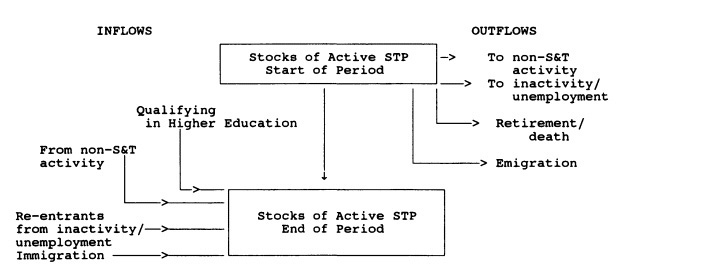
NOTE: This early stock and flow chart will be considerably amended in the final version of the HRST manual.
SOURCE: Institute of Manpower Studies, Falmer, Sussex, United Kingdom.
FIGURE 1 Principal stocks and flows of S&T personnel.
FULL-TIME EQUIVALENCE VERSUS HEAD-COUNT
Internationally comparable R&D personnel data have been collected in terms of full-time equivalence (FTE) only. While FTE series are considered more accurate than head-count data for international comparison of the R&D volume proper, they do not permit serious comparisons with other personnel series, such as population, education, and labor statistics. However, this is being amended. The new (1992) version of the Frascati manual recommends, for example, that R&D head-count data also be collected. This is a direct consequence of increased interest in human capital resources and constitutes the necessary linkage between the Frascati manual on R&D and the new manual under development for the measurement of total stocks and flows of S&T personnel.
COMPATIBILITY WITH INTERNATIONAL CLASSIFICATIONS
For all these breakdowns, internationally adopted classifications should be used, such as UNESCO's International Standard Classification of Education (ISCED), the International Labor Office's International Standard Classification of Occupations, and the United Nations' International Standard Industrial Classification and System of National Accounts, of which the latter three have just been revised. Revision work has also been initiated of ISCED, which defines different levels of education and detailed fields of study classification.
Besides traditional demographic statistics needed as a basis for forecasting and modeling, a variety of other factors of importance for international comparisons of human S&T resources systems are also discussed in the draft HRST manual, such as shortages and vacancies, salaries, retirement ages, and attitudes to S&T studies and careers.
WHAT NEXT?
Following the discussions at the 1992 workshop, work has continued with a view toward improving the concepts for measuring HRST. A first revised version of the manual, which draws to a large extent on the findings of the inventory of national and international practice and experience described earlier, was circulated to OECD, Eurostat, and UNESCO experts during the summer for another round of technical discussions in the fall of 1993. (The experts' final "green light" was given to the second revised version of the HRST manual at a meeting in Canberra, Australia, in April 1994, and it is hoped that it will be available as a "general distribution" OECD publication before the end of 1994.)
In the meantime, it is also hoped that the provisional guidelines will be tested in practical ways, notably within the framework of the ambitious project on Scientific, Technical, and Engineering Personnel at Industry, Science, and Technology Canada. OECD is taking steps to use notably some of the already available (and reasonably internationally comparable) third-level educational statistics for this purpose.
The Trends in Scientific and Engineering Personnel in Japan and the Focus of Research in the National Institute of Science and Technology Policy
Hajime Nagahama
ESTABLISHMENT OF NISTEP AND ITS TASKS
The National Institute of Science and Technology Policy (NISTEP) was founded in July 1988 as an organization within the Science and Technology Agency. NISTEP analyzes the increasingly complex and diverse circumstances surrounding science and technology (S&T) and carries out both theoretical and empirical studies on various subjects with an eye toward forming a S&T policy geared to the needs of a new age.1
Toward this end, NISTEP, in close cooperation with the Council for Science and Technology Policy and other related domestic organizations, as well as with foreign organizations involved in S&T policy, engages in research activities while positively promoting exchanges with researchers at home and abroad. (See Figure 1.)
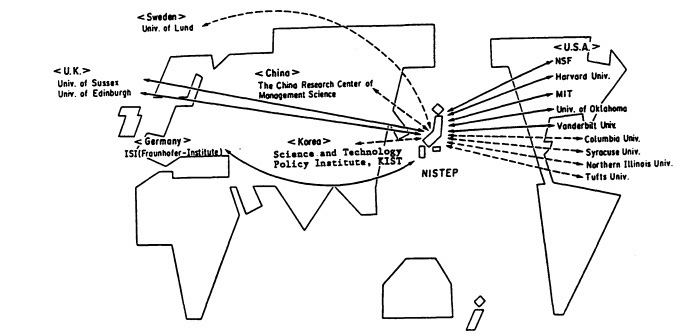
FIGURE 1 Cooperation overseas.
BACKGROUND OF THE PROBLEM OF SCIENTIFIC AND ENGINEERING PERSONNEL IN JAPAN
Historical Character of Education for Scientific and Engineering Personnel
Since the Meiji Restoration, the Japanese government has imported western S&T as a combined civilization. The Meiji government sent many students to study abroad and, in parallel, employed many foreign scientists and engineers to modernize, enrich, and strengthen Japan.
Engineering education has been emphasized in the national educational policy since the Meiji era. Therefore, Japanese universities have had both science and engineering faculties and have educated both scientists and engineers since the early period. The national government has mainly taken responsibility in fostering scientific and engineering personnel in Japan.
Current Situation in Scientific and Engineering Personnel Supply
The supply and demand gap of scientific and engineering personnel will continue both in quantity and quality. In recent years many excellent university graduates in the scientific and engineering fields have decided to work in the banking and insurance industries and not in manufacturing industries. Aware of the decline of scientific and engineering facilities in Japanese universities, people anticipate new policies aimed at promoting personnel in advanced and basic science and engineering fields.
Problems and Prospects in the Near Future in Japan
-
Shortage of young human resources and aging of demographic structure (see Figure 2)

SOURCE: Planning Division, Higher Education Bureau, Ministry of Education, Science, and Culture, Japan.
FIGURE 2 Demographic change of 18-year-olds and the scale of higher education.
-
Changing attitudes of youth toward S&T (young people drift away from S&T) (see Figure 3)
-
Diversification and globalization of scientific and engineering personnel supply—female, aged people, and foreigners
MAIN CONTENTS AND FOCUSES OF RESEARCH CONCERNING SCIENTIFIC AND ENGINEERING PERSONNEL IN NISTEP
Main research concerning scientific and engineering personnel is classified into the following six groups by theme:
-
Research on public understanding of S&T and STS communication
-
Research on careers and professional activities of scientific and technology personnel
-
Research on trends of S&T careers through S&T award
-
Research on choice of field by university applicants and employment trends of science and engineering graduates
-
Research on science and engineering doctorates in Japan
-
The Japanese S&T indicator system
Next, I will talk about the simple summary of respective studies belonging to the above themes.
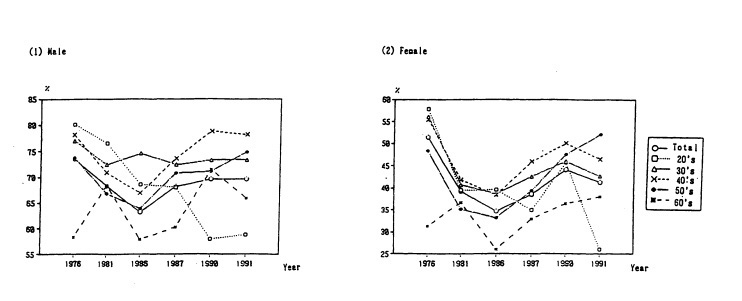
SOURCE: 1991 Survey: AC, Opinion Survey of Science and Technology Other Surveys: Public Relations Division, Prime Minister's Office, Opinion Survey on Science, Technology, and Society, Japan.
FIGURE 3 Changing ratio of interest in news and topics on science and technology.
Research on Public Understanding of S&T and STS Communication
Studies belonging to this group are based on public opinion surveys toward S&T, and study the hypotheses and structure models of public attitudes and acceptance of S&T, the S&T triad, and scientific literacy. These studies aim at analyzing attitudes toward S&T, measuring scientific literacy, and encouraging smooth communication between the public, scientists and engineers, and organizations (government, private enterprises, etc.). (See Figure 4.)
The studies belonging to this group started from the study of Science, Technology, Society, and Communication (STSC study) (ATS Report No. 17, March 1991) by the 2nd Policy-Oriented Research Group.
This study concluded that the public, scientists and engineers, and organizations (government, private companies, etc.) have to maintain smooth communication through co-ownership of scientific and technological information in the prospective society, which is highly industrialized by advanced S&T, and proposed a S&T triad model, concepts of STCC and SCC, in order to understand their relation.2
The study group developed a hypothesis based on the S&T triad shown in Figure 5. This communication model represents the social relation of S&T communication.
Research on Careers and Professional Activities of Scientific and Technology Personnel
The 2nd Policy-Oriented Research Group published a report Public Attitudes on Science and Technology: Based on Opinion Survey Results (NISTEP Report No. 2, June 1989) in connection with the above STSC study.
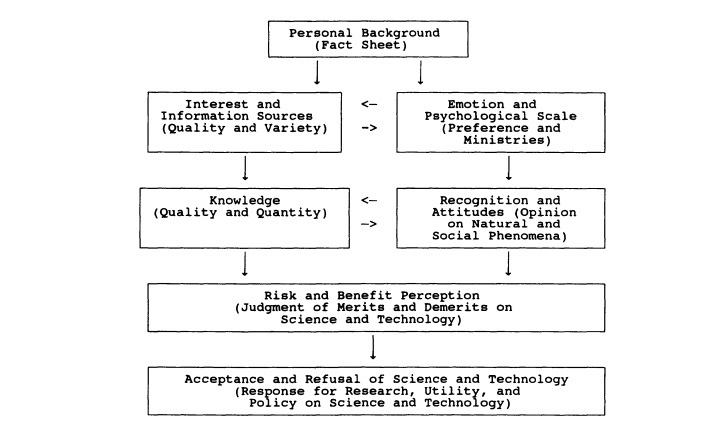
SOURCE: Study Group for the International Comparative Study of Public Understanding of Science and Technology, Japan.
FIGURE 4 Structural model of public attitudes and acceptance of science and technology.
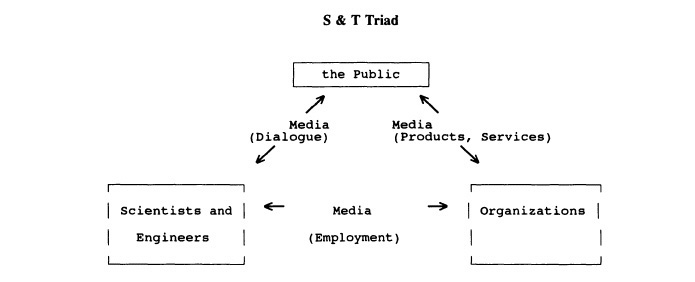
SOURCE: NISTEP Report No. 17, Science, Technology, Society, and Communication.
FIGURE 5 The communication model among the public, scientists and engineers, and organizations (S&T Triad).
Since 1990, NISTEP has participated in an international comparative study of Public Understanding of Science and Technology.3
NISTEP organized an international symposium on public understanding of S&T and science and mathematics education in Tokyo in October 1992 in cooperation with the International Council Group of the above international comparative study.
Studies belonging to this research theme aim at looking for directions to improve research conditions for Japanese scientists and engineers who are doing creative research activities.
The 2nd Policy-Oriented Research Group administered two studies under this theme. The first study resulted in a report on the Background and Professional Activities of Natural Science Research Personnel in Japan (NISTEP Research Material No. 20, February 1992). This report compiled the results of two surveys.
The first survey emphasized from which universities Japanese university teachers in natural science fields received their doctorates. It included university teachers in natural science fields working at all national and public universities and 10 selected private universities. The second survey showed the actual activities and professional careers of graduates. It included 678 researchers in universities, national and public laboratories, and private enterprises.
The report of the second study dealt with The Interchange of Researchers and Engineers Between Japan and the Other Countries (NISTEP Report No. 16 and NISTEP Research Material No. 12, March 1991). This study was based on the following three government statistics:
-
Annual Report of Statistics on Legal Migrants, Ministry of Law
-
Statistics on Foreigners Staying in Japan, Ministry of Law
-
Annual Report of Statistics on Japanese Nationals Overseas, Ministry of Foreign Affairs
The report features the actual results of the exchange of researchers and engineers between Japan and other countries for a period of 20 years (1970-1989) by object, nation, and region. (See Figures 6 and 7.)
Research on Trends of S&T Careers Through S&T Award
This research aimed at emphasizing the research conditions and highlighting excellent research cases that were awarded by the Minister of State for S&T. The
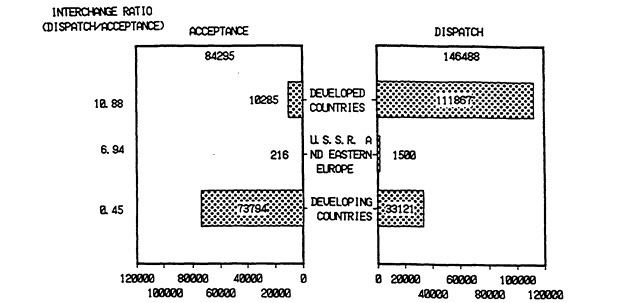
SOURCE: NISTEP Report No. 16, The Interchange of Researchers and Engineers between Japan and Other Countries: Study based on Annual Report of Statistics on Legal Migrants, Statistics on Foreigners Staying in Japan, and Annual Report of Statistics on Japanese Nationals Overseas.
FIGURE 6 Dispatch and acceptance of researchers and engineers (1989).
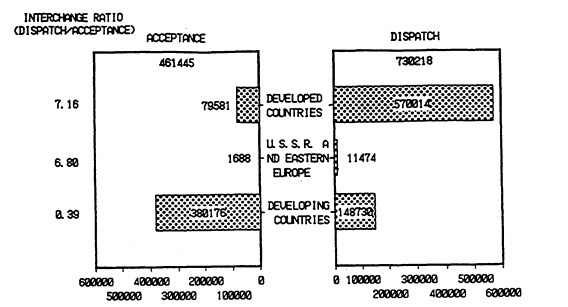
SOURCE: Report No. 16, The Interchange of Researchers and Engineers Between Japan and Other Countries: Study based on Annual Report of Statistics on Legal Migrants, Statistics on Foreigners Staying in Japan, and Annual Report of Statistics on Japanese Nationals Overseas.
FIGURE 7 Dispatch and acceptance of researchers and engineers (20 years).
first step of this study was published as the Trends of Science and Technology Activities in Japan Using Science and Technology Award Statistics: Persons of Scientific and Technological Merits, Commendation by the Minister of State for Science and Technology (NISTEP Report No. 10, March 1990). In this report, 637 cases over 31 years (1959-1989) were listed and analyzed from multiple viewpoints.
This research now steps into the second round, where several remarkable cases are selected from those included in the first step of the study. Next, we are going to analyze and study the excellent achievements and the research conditions that bring about such achievement. The results of this study will be published by the end of 1993.
Research on Choice of Field by University Applicants and Employment Trends of Science and Engineering Graduates
Three NISTEP reports and one seminar report were published in this group.
The first report considered the Employment Trends of Science and Engineering Graduates (NISTEP Report No. 1, June 1989). This study focused on the trend since 1985 of a fair number of the most excellent graduates from science and engineering faculties (undergraduate level) finding employment in service industries, such as banking or insurance, not in manufacturing industries. This report also analyzed the reasons for and the prospects of this trend.
The second report was on the Choice of Fields of Study Among University Applicants: How Many Young People in Japan are Planning to Study Science and Engineering in Universities? (NISTEP Report No. 12, August 1990). Based on the results of a survey that sampled approximately 4,000 Japanese high school students, this study analyzed the students' attitude toward S&T and the choice of fields these students desired to enter into at universities.
The third report was on How the Information on Science and Technology Activities Should Be Sent to Younger Generations—Based on the Analysis of the High School Students' Attitudes Toward Career Selection and Science and Technology (NISTEP Report No. 24, October 1992). This report discussed the possibility of enhancing scientific and technological human resources through improving the scientific and technological information to Japan's younger generation. The contents of this report were based on the second analysis of survey results conducted for NISTEP Report No. 12. (See Figure 8.)
The fourth, a seminar report, described the Savages in a Civilized Society—Young Peoples' Drift Away from Science and Technology (NISTEP Seminar Report No. 26). This report is a record of a March 1991 speech by Mr. Shin'ichi Kobayashi, a visiting researcher of NISTEP. Mr. Kobayashi proposed a hypothesis based on The Revolt of the Masses by Jose Ortega y Gasset, a Spanish philosopher, and applied his hypothesis to the results of the above survey of high school students. (See Figures 9, 10, and 11.)
Research on Science and Engineering Doctorates in Japan
Research in this group aims at strengthening policies to encourage doctoral programs in the S&T fields. It also covers the basic problems in doctoral courses.
The first study was a report on the Quantitative Comparison of Science and Engineering Doctorates in Japan and the United States—Training of Researchers in Japanese Doctoral Programs (NISTEP Report No. 7, December 1989). This study focused on the quantitative comparison of doctoral courses in science and engineering fields between Japan and the United States, especially the awarded number of doctorates between these two nations. (See Figure 12.)
The second report focused on Conditions of the Strengthening of Doctoral Course in Natural Science Fields (NISTEP Research Material No. 26, November 1992). Based on survey results and interviews with university professors, private enterprise leaders, researchers, and students in graduate courses, this study recommended some schemes to encourage Japanese scientific and technological research by strengthening doctoral courses.
The Japanese S&T Indicator System
NISTEP published its first report on the Japanese S&T indicators system in September 1991. In this report, indicators concerning S&T were composed in Chapter 2 and in some clauses in other chapters.
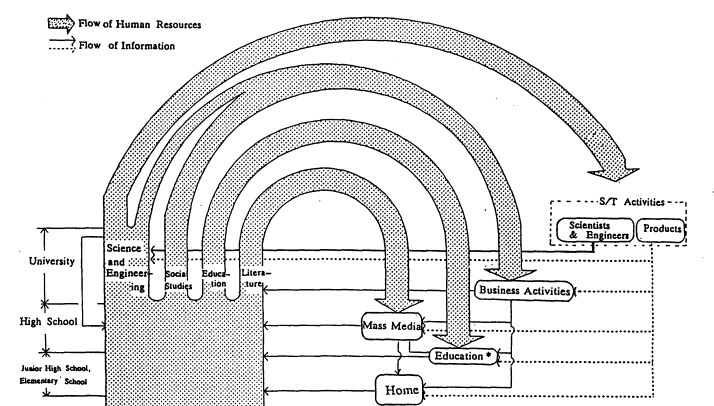
• ELEMENTARY AND SECONDARY EDUCATION
SOURCE: NISTEP Report No. 24, How the Information on Science and Technology Activities Should Be Sent to Younger Generations-based on the Analysis of the High School Students' Attitudes Toward Career Selection and Science and Technology.
FIGURE 8 Model of information flow on youth's career selection and science and technology activities.
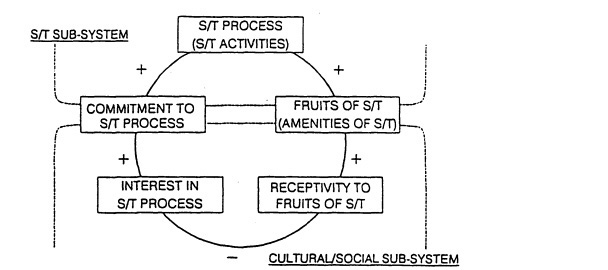
SOURCE: NISTEP Seminar Report No. 26, May 8, 1991, Savages in a Civilized Society-Young People's Drift Away from Science and Technology.
FIGURE 9 Formulating the ''Savages in a Civilized Society" hypothesis.
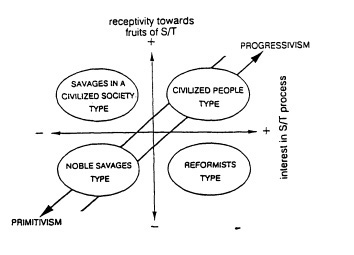
SOURCE: NISTEP Seminar Report No. 26, May 8, 1991, Savages in a Civilized Society—Young People's Drift Away from Science and Technology.
FIGURE 10 Classification of people's attitudes toward science and technology.
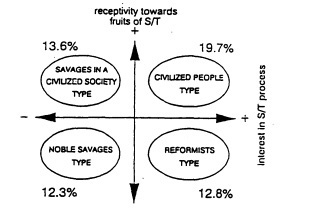
SOURCE: NISTEP Seminar Report No. 26, May 8, 1991, Savages in a Civilized Society—Young People's Drift Away from Science and Technology.
FIGURE 11 Distribution according to survey of high school students.
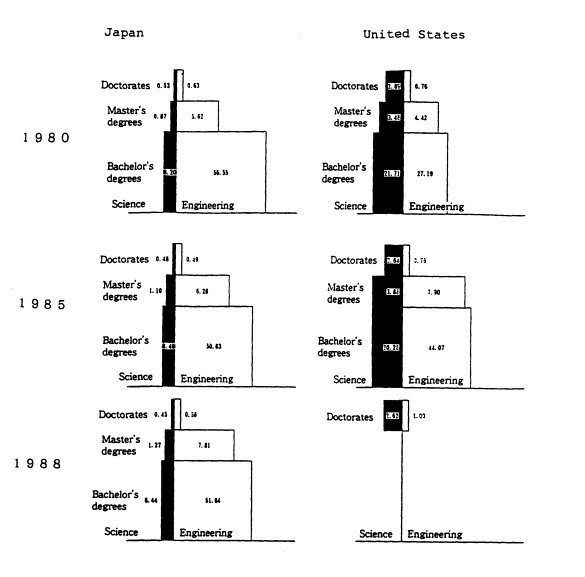
NOTE: Numerical values represent number of persons per unit population (100,000 people). Foreign students are not included. The number of Japanese doctorates per unit population is equivalent to the number of young doctorates, with 1980 representing fiscal 1979, 1985 representing fiscal 1984, and 1988 representing fiscal 1987.
SOURCE: NISTEP Report No. 7, Quantitative Comparison of Science and Engineering Doctorates in Japan and the United States.
FIGURE 12 Comparison of science and engineering human resource supply structure in Japan and the United States.
CONCLUSIONS
Through the above research, NISTEP has focused on three points about the essence of S&T career problems.
-
Encourage good relations in communication between the public (especially the younger generation), scientists and engineers, and organizations (government, private enterprises, etc.) regarding common S&T information.
-
Improve the educational system, especially in doctoral programs that train scientific and technological researchers in Japan.
-
Ensure high salaries for and good treatment of scientists and engineers in society.
In general, the Japanese people have created a highly industrialized society through great effort to modernize, westernize, and industrialize their nation over the past 100 years. During this period, Japan's social system and industrial structure has changed entirely, especially in the research fields of S&T. Although the gap between Japan and the western world continues to narrow, there are a few fields that are exceptions. These exceptions include the scarcity of doctoral programs in universities and the weakness of an informal public relations system in S&T information (especially in the academic world and the public).
Finally, I would like to emphasize that NISTEP aims to encourage international cooperation and to contribute to S&T policy research. The S&T career problem is one of the most important themes that NISTEP is now tackling.
REFERENCES
2nd Policy-Oriented Research Group. 1992. The 5th Technology Forecast Survey - Future Technology in Japan (Japanese and English).
2nd Theory-Oriented Research Group. 1989. Preliminary Study on Regional Promotion of Science and Technology Throughout Japan (Interim Report) (Japanese).
4th Policy-Oriented Research Group. 1990. Development and Use of Biotechnology and Its Influence: Problem on Practical Use of Biotechnology (Japanese).
4th Policy-Oriented Research Group. 1989. Investigation of the Situation and the Structure of Energy Consumption in Asia and the Global Problems Anticipated Due to Increasing Energy Utilization (Interim Report) (Japanese and English) (abstract only).
4th Policy-Oriented Research Group. 1990. Preliminary Study on Promotion of Regional Science and Technology Throughout Japan (Japanese).
Hirano, Y. and C. Nishigata. 1990. "Basic Research" in Major Companies of Japan (Japanese and English).
Kagita, Y. and F. Kodama. 1991. Ratio Analysis of R&D Expenditure vs. Capital Investment in Japanese Manufacturing Companies: From Producing to Thinking Organizations (Japanese and English).
Kato, N., Y. Ogawa, T. Koike, T. Sakamoto, and S. Sakamoto, et al. 1991. Analysis of Structure of Energy Consumption and Dynamics of Emission of Atmospheric Species Related to the Global Environmental Change (SOx, NOx, CO2) in Asia (Japanese and English).
Kiba, T. and F. Kodama. 1991. One Approach on Measurement and Analysis of International Technology Transfer: A Case Study on Japanese Firms' Direct Investment into East Asian Countries (Japanese and English).
Kikuchi, J., S. Mori, Y. Baba, and Y. Morine. 1990. Development of Input-Output Model for Science, Technology and R&D (Interim Report): R&D Dynamics (Japanese and English).
Kikuchi, J., S. Mori, and M. Morino. 1989. Development of Input-Output Table for Science, Technology and R&D (Interim Report): Theoretical Framework of Input-Output Model for Science, Technology and R&D (Japanese).
Koba, K., S. Ishiyama, and H. Nagahama. 1992. Background and Professional Activities of Natural Science Research Personnel in Japan (Japanese).
Kobayashi, S., H. Endo, E. Sato, and Y. Hirano. 1992. How the Information on Science and Technology Activities Should Be Sent to Younger Generations—Based on the Analysis of the High School Students' Attitudes Toward Career Selection and Science and Technology (Japanese and English).
Kobayashi, S. 1991. Savages in a Civilized Society—Young People's Drift Away from Science and Technology (Japanese and English).
Mori, S., J. Kikuchi, Y. Baba, and H. Mitsuma. 1992. Development of Input-Output Table for Science, Technology and R&D: Some Results and Policy Implications (Japanese).
Muto, E. and Y. Hirano. 1991. Government Laboratories and Basic Research: Toward the Promotion of Basic Research in Government Laboratories (Japanese and English).
Nagahama H., T. Kuwahara, and T. Nakahara. 1989. Public Attitudes on Science and Engineering: Based on Opinion Survey Results (Japanese and English).
Nagahama, H., T. Kuwahara, A. Nishimoto, and the STSC Study Group. 1991. Science, Technology, Society and Communication (Japanese and English).
Nanahara, T., and F. Niwa. 1990. Trends of R&D Activities in Japanese Companies Using Patent Statistics (Japanese).
Nishigata, C., A. Nakanishi, and Y. Hirano. 1989. Employment Trends of Science and Engineering Graduates (Japanese and English).
Nishigata, C. and Y. Hirano. 1992. Increasing the Number of High Quality Science and Engineering Taught - Course Doctorates in Japan (Japanese).
Nishigata, C. and Y. Hirano. 1989. Quantitative Comparison of Science and Engineering Doctorates in Japan and the United States: Training of Researchers in Japanese Doctorate Courses (Japanese and English).
Nishimoto, A. and H. Nagahama. 1991. The Interchange of Researchers and Engineers Between Japan and Other Countries: Study Based on Annual Report of Statistics on Legal Migrants, Statistics on Foreigners Staying in Japan, and Annual Report of Statistics on Japanese Nationals Overseas (Japanese and English).
Nishimoto, A. and H. Nagahama. 1990. Trends of Science and Technology Activities in Japan Using Science and Technology Awards Statistics: Persons of Scientific and Technological Merits, Commendation by the Minister of States for Science and Technology (Japanese).
Niwa, F., H. Tomizawa, F. Hirahara, F. Kakizaki, and O. Camargo. 1991. The Japanese Science and Technology Indicator System: Analysis of Science and Technology Activities (Japanese and English).
Sato, E., H. Kikuchi, and Y. Hirano. 1990. Choice of University Applicants Among Fields of Study: How Many Young People in Japan are Planning to Study Science and Engineering in Universities? (Japanese and English)
Shirai, I. and F. Kodama. 1989. Quantitative Analysis on Structure of Collective R&D Programs by Private Corporations in Japan (Interim Report) (Japanese and English) .
Watatani, H., T. Yamamoto, K. Gonda, and T. Sakamoto. 1992. Study of Regional Science and Technology Promotion: Analysis of Science and Technology Policies by Local Governments (Japanese).
Developing Data Systems on Trends in Science and Technology Careers
Glynis Breakwell
My task is to explore how the research described in the papers of Westholm and Nagahama assist us in monitoring trends in science and technology (S&T) careers. It is also my task to examine what other factors should be taken into account when developing information collection procedures that will provide adequate data systems for policymaking concerning human capital resources in S&T.
WHAT DATA ARE NEEDED?
Three types of data are actually needed in policymaking in this area:
|
Type 1. |
Data on what S&T personnel exist at any one point in time. |
|
Type 2. |
Data on the patterns of change in S&T personnel over time. |
|
Type 3. |
Data on the factors that influence changes in both the quality and quantity of S&T personnel. |
Type 1 data are what Westholm calls information on the stock of S&T personnel. Type 2 data are what he calls the flow of such personnel. Type 3 data, which are by far the most complex, seem to me to be the main target for the substantive work described by Nagahama. It could be argued that a fourth type of data should also be collected: on availability of jobs per se. The availability of jobs should not be confused with availability of careers. Data on careers would entail a longitudinal perspective following individuals over time.
WHAT PROBLEMS MUST BE OVERCOME IN CREATING DATA SYSTEMS?
Problem 1: Comparability—Geographical and Temporal
Any decent data system requires unambiguous categories or units of measurement. We are certainly not faced with a dearth of stock and flow data. As Gunnar Westholm explained, these exist for extended time periods in some countries. We lack comparable data—comparable, that is, across time and across place.
At one level, the lack of comparability is merely a product of confusion of terminology. Either the same word is given different usages or different words are given the same usage. There is, for example, the perennial problem of the meaning of technician. At a rather more significant level, comparability is lost because data collection procedures differ. In this case, the category or unit of measurement is agreed, but the data collected varies in accuracy or rigor. The reasons for differences in data collection procedures are numerous. They should be examined by all who are interested in ensuring valid and reliable data systems. Only by identifying the nature of these differences and the reasons why they are perpetuated will we begin to know how to regulate the research community in such a way as to achieve data comparability.
There is, however, a super ordinate question: Why do we need international comparability? This would imply either the existence of international policymaking or an international S&T job market. Neither currently exist except for a relatively small number of high-level jobs.
Problem 2: Specificity
Achieving data at sufficiently specific levels of description has been a problem. Aggregation of data at the level of the lowest common denominator has been necessitated by the low levels of comparability. As categories or units of measurement have become more specific, their implications have been more selective and idiosyncratic. Westholm rightly emphasizes OECD's problems in this regard. He argues they result in macro rather than micro levels of data being used in any comparisons across countries. There is obviously some trade-off between comparability and specificity at the moment. This is not inevitable, but if it is to be avoided, there will need to be even greater international collaboration in establishing the definition of the categories or units of measurement used.
There is, however, another problem that militates against the development of more specific S&T data. It stems from the nature of S&T activities and the way in which they are embedded in economic and policy systems. At the heart of S&T development is the creation of new job categories and different career structures. This makes it necessary for data systems to anticipate trends in order to ensure that the information collected is relevant and up-to-date. Such anticipation is not often possible. The more specific the unit of measurement, the more it is open to becoming redundant as scientific and technological changes transform labor demands. It seems that it is important for policymakers to decide the levels of specificity that will optimize planning. These levels will, of course, vary according to the precise S&T domain under consideration. It is conceivable that in areas where changes are less frequent or significant, high levels of specificity will be feasible. The point is, however, that the level should be dictated by planning requirements rather than convenience. It would have been useful if the papers by Westholm and Nagahama had considered what new structures might be needed at the international governmental level to establish optimum specificity in data sets.
Problem 3: Periodicity
Regular periodic data collection is needed but does not actually happen in most countries. Currently, there is an unhealthy reliance upon ad hoc studies or, as Westholm argues, tacking extra questions on to other surveys. What seems to be needed is the education of national data collection agencies about the purpose and value of having, firstly, regular data and, secondly, internationally coordinated schedules of data collection. National agencies need to be persuaded that involving the international research community in developing the instruments used in data collection is worthwhile. It is necessary for us to prove the policy value of such statistics. Examples of the proven worth of these types of data sets would have been valuable in the papers by Westholm and Nagahama.
If systems of regular periodic data collection were established, they might act as something of an antidote to one of the major problems in existing practice. Typically there are substantial time lags between data collection, analysis, interpretation, publication, and policy application. This often means that policy is based upon statistics that are out-of-date and misleading. Regular data sweeps would encourage streamlining of data handling as routines were introduced. Regularity would allow better trend analysis and once established these trends would focus the direction of initial analyses, speeding interpretation. Needless to say, regular sweeps would also be likely to create a group of researchers with specific expertise.
Problem 4: Structuring the Data
Issues of comparability, specificity, and periodicity tend to distract us from the equally significant problems associated with determining what data are really necessary. Westholm's model of stocks and flows of S&T personnel is undoubtedly a useful starting point in examining these problems. It is underpinned by the UNESCO distinction between the total stock of qualified manpower and the number of economically active qualified manpower (which begs the question: does qualified refer to educational or occupational achievements? But that can be left aside for now). This distinction has to be further broken down into those who are qualified and working in S&T and those who are qualified but working in some other area. These two criteria for dichotomizing the stock of S&T
personnel essentially yield the model proposed. I cannot accept the label Westholm gives the flow diagram; it is a way of systematizing what we need to know, but it is not a theory. It is actually the cross-classification, which he says is too ambitious, of inflow and outflow information with detailed breakdowns by, for example, type of personnel, occupation, sector of employment, educational background, age, gender, nationality, etc., which would allow an explanatory or predictive theory to be developed. Such cross-tabulation is the only way to generate a model specifying what factors influence the patterns of inflow and outflow.
The schematic, as it stands, focuses solely upon the extent to which the active stock of S&T personnel (STP) is maintained. Another complementary schematic is needed to represent movement within the active stock between categories or career or job. Such a schematic would need to represent changes in the structure of the STP stock in terms of age, gender, sector of employment, fields of qualification, location, etc., across time. These changes in the structure of the stock are important in policymaking.
Once the changes in the structure of the STP stock are treated seriously, another question is raised. The topic of this conference is trends in S&T careers, not jobs. The concept of career implies the need to consider what happens to a person over time in terms of education and employment. The model of data collection implicit in Westholm's schematic is cross-sectional, not longitudinal. It would make it difficult to establish anything about trends in scientific and technical careers except through tenuous extrapolation. A simple example serves to illustrate this point. Let's say that half of the STP stock occupied research and development jobs and the other half did not (I realize this is unimaginable) at time one (1993) and the same proportions exactly were found to apply at time two (2093). (It could be that the individuals in each sector had remained the same or it could be that some proportion of individuals had switched sectors. As long as the proportions switching were identical, the results would be the same.) From such data, we know nothing about careers per se. In order to understand something about careers, we need information on one individual across his or her life span. This is, of course, the area where Nagahama's report offers great hope. It is evident, even from the very brief descriptions given, that the Japanese research is focusing upon the structure of scientific careers.
Nagahama's summary of research activity at NISTEP reveals an emphasis on modeling the factors that influence changes in the inflow and outflow of STP. The studies of public understanding of science, the assessment of the impact of educational policy, and the effectiveness of intervention techniques are all motivated by the need to understand how people come to choose and maintain effective careers in S&T. Of course, such studies are based on quite different types of information from the stock and flow model of Westholm. These data are probably even less open to tight international comparability. In fact, comparability in such studies at the level of the operational definition of indexes might be pointless. Cultural differences in the factors affecting career decisions may make cross-cultural comparability in data collection redundant as well as impossible. Cross-cultural comparability will probably have to be achieved at the level of theoretical rather than operational constructs. This may not be too severe a problem if the forecasts within cultures are good. After all, these data are designed to serve a different function from the statistics on overall stocks and flows. While stocks and flows data primarily reveal availability, these data are the basis for manipulating availability.
The ultimate objective of such modeling of the factors influencing career choice and change would be prediction and manipulation of trends in STP stocks. Westholm regards prediction or forecasting as hazardous and too difficult. Yet I am glad to see Nagahama's Institute attempting it at some levels. Without forecasting, such exercises become merely descriptive—a sort of statistical historicism. Since the data are always retrospective, they come to have a less influential role in policymaking.
CONCLUSION: CONFRONTING THE PROBLEMS
Specification of the problems takes us some way toward their solution. In fact, it seems we know pretty well what sorts of data are needed on stocks and flows of STP. We also know what factors should be explored in establishing predictive models. The difficulties lie at the pragmatic rather than the conceptual level. It is the financial and political constraints that make progress slow. We should be discussing how to overcome them.

